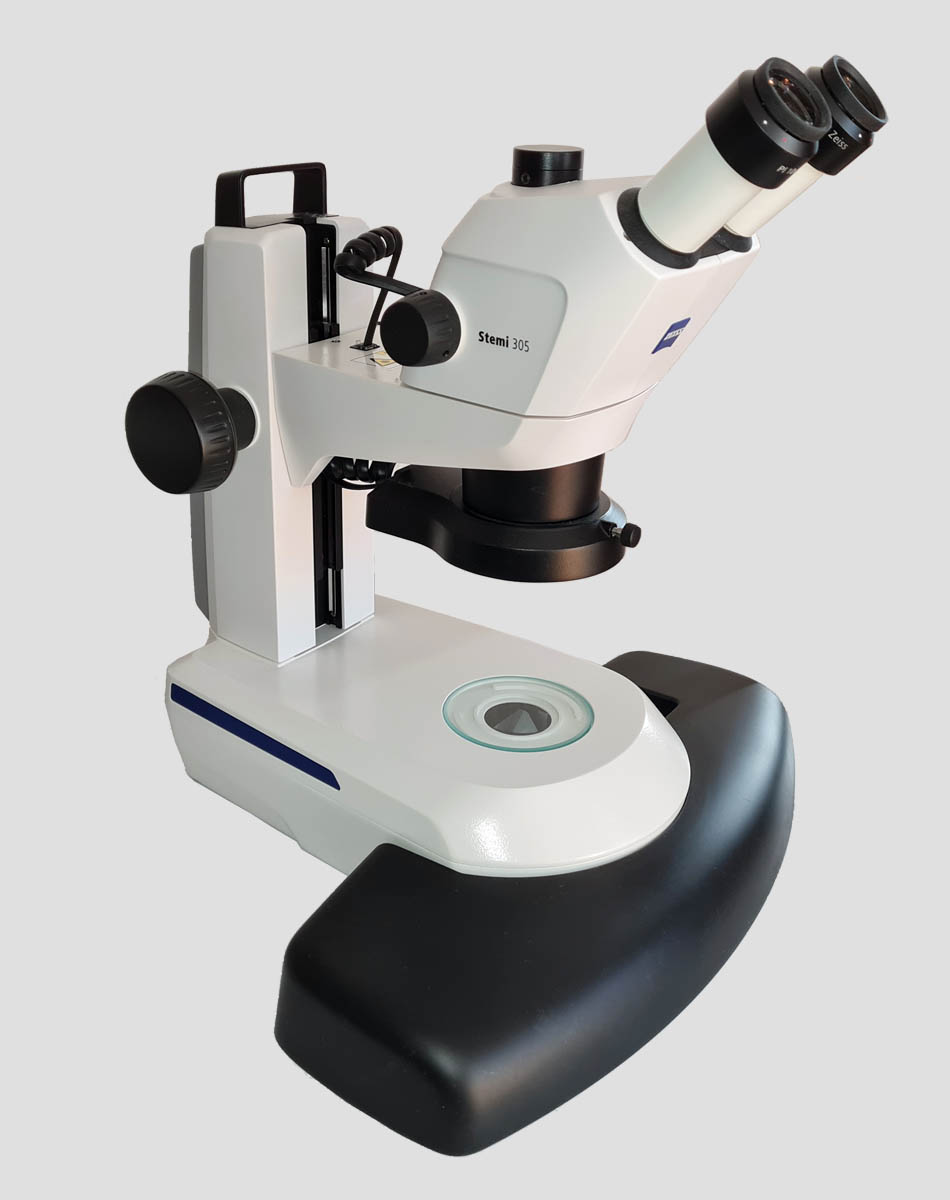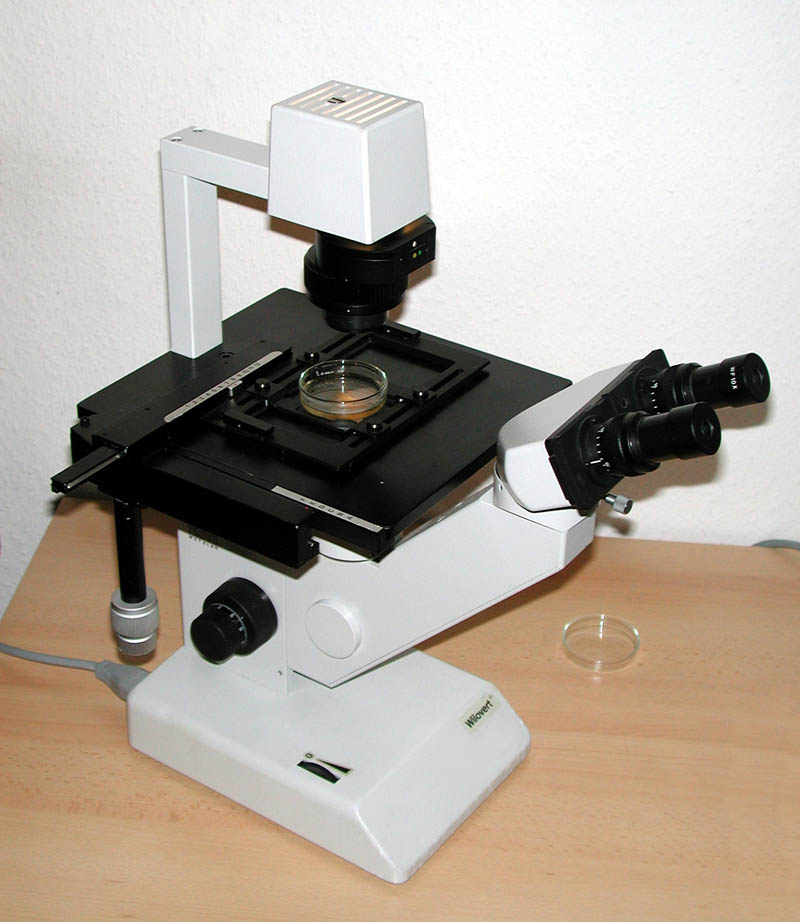
Auxiliaries for cultivation
There will be a few hints for equipment and tools that are important for cultivation. It has already been written about suitable nutrient solutions and lamps.
Stereomicroscope
A stereomicroscope is particularly suitable for selecting diatoms and for transferring them into cultures. Especially in dark field, diatoms can be easily found and pipetted. A high-contrast dark field is achieved by using an inclined mirror in the stand of the stereomicroscope. As the mirror leads to a large height of the stand, a hand rest is required for pipetting. If such a device is not available, one can make use of a matte, black plate under the Petri dish. Care should be taken that the Petri dish does not rest on the black plate but is at such a distance from it that its surface structures are not in focus with the diatoms. For most cases, a magnification of 10x to 30x is sufficient. Ring illumination is well suited for illumination, and switchable segments are advantageous. A camera port enables documentation and also allows observations with a large field of view. The image on the right shows the used Zeiss Stemi 305 with the K LAB stand. Video cameras can be used via a C-mount connector, and a reduction with a factor of 0.5 is built in.
Inverse microscope
For checking cultures a simple inverse microscope is preferable to a stereomicroscope. With it one can quickly detect impurities due to the higher magnification.
To assess cultures, brightfield and objectives with small magnifications, such as a 5x, 10x and possibly a 20x objective are sufficient. An object-guide is useful for capturing images and videos, but is a hindrance to the fast-paced viewing of many petri dishes.
 The requirements for live observation in petri dishes are higher. Comments are made in the post on observation devices. An appropriately equipped inverted microscope can be used for both purposes. The picture on the left shows the older inverse routine microscope Wilovert (Helmut Hund GmbH) used by me. It has also been used for many of the videos shown as it has phase contrast and objectives with suitable magnifications. The images were taken using an eyepiece adapter attached to one of the two eyepieces. In connection with observation accessories an inverse microscope with more extensive equipment is presented.
The requirements for live observation in petri dishes are higher. Comments are made in the post on observation devices. An appropriately equipped inverted microscope can be used for both purposes. The picture on the left shows the older inverse routine microscope Wilovert (Helmut Hund GmbH) used by me. It has also been used for many of the videos shown as it has phase contrast and objectives with suitable magnifications. The images were taken using an eyepiece adapter attached to one of the two eyepieces. In connection with observation accessories an inverse microscope with more extensive equipment is presented.
Petri Dishes
As our goal is not the achievement of a large biomass, petri dishes are well suited as culture vessels. We recommend polystyrene (PS) petri dishes for one time use. Reusable petri dishes made of glass allow observation in differential interference contrast (DIC) but the effort for cleaning is significant. We use sterile bacteriological petri dishes with a diameter of 55 mm. Therein enough diatoms can be cultivated and the space requirement for cultivation in one's own home remains acceptable. In order to reduce the risk of aerial contamination and to avoid water loss by evaporation, we prefer petri dishes without ventilation ribs. As the cultures are kept at room temperature and are not incubated, there is hardly any danger that the water condenses on the lid and makes observation more difficult.
Pipettes
In order to pick diatoms from a fresh sample a micropipette with a sufficiently small tip is needed, so that the probability of contamination is low. Its diameter should be about twice as large as the diatoms to be taken, that means between about 20 µm to 100 μm depending on the size of the diatoms.
A pipette with a long, thin capillary creates a strong pull of water for a few seconds, which can usually detach diatoms from the substrate without contact. However, the longer the pipette, the more difficult the handling.
When taking diatoms from a pure culture, pipettes with a larger capillary diameter can be used in most cases.
Micropipettes can easily be produced from a glass or quartz tube. For this purpose, a glass tube is heated above a Bunsen burner or a soldering lamp. Roll it carefully between your fingers. Once the glass is soft enough remove the tube from the flame and pull the two ends apart. The faster you pull, the thinner the capillary becomes. After cutting through the halves one has two pipettes with the same opening.
Luxmeter
There are no high requirements on the measuring accuracy of the luxmeter. A comparison of cheap with expensive devices has shown that cheap devices are sufficient for cultivation. There are also luxmeter apps for smartphones. Unfortunately, trying to use one of these apps was not successful. It is quite possible that there are apps with sufficient accuracy available.
Measuring device for salinity
For cultivating marine diatoms, a measuring instrument for measuring salinity is required, such as a hydrometer, refractometer or conductivity meter. Information was given in the section on nutrient solutions.
Others
To prepare the nutrient solution, an Erlenmeyer flask, sufficiently accurate scales, a graduated pipette, a thermometer and possibly Ph test strips are sufficient.





